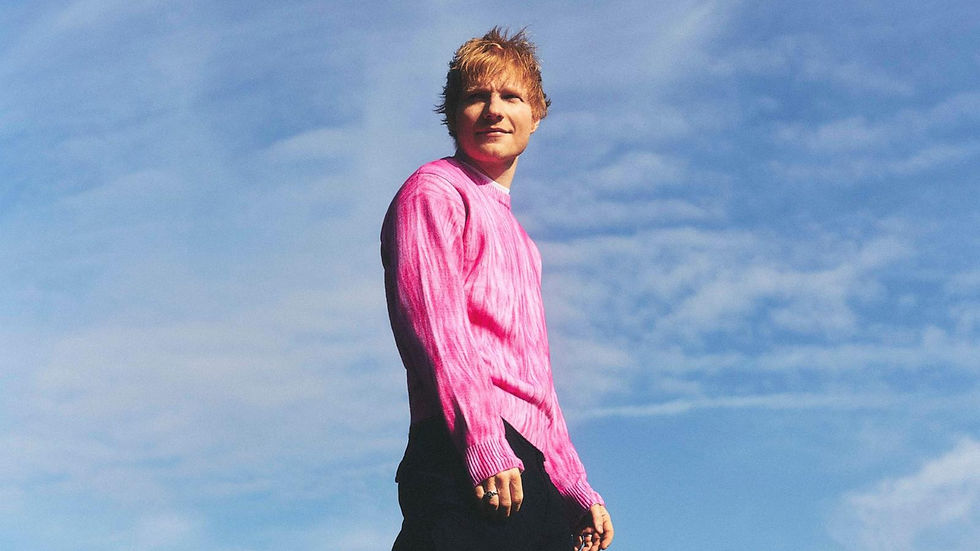Pressing Play on Ed Sheeran: Highs, Lows, and the Best Way to Listen
- LJ Portnoy

- Sep 18
- 4 min read
Written by LJ Portnoy, Editor-in-Chief

Pressing Play
Ed Sheeran’s Play is the first in his new “media control” series (Play, Pause, Rewind, Fast Forward, Stop), and it’s the most sonically adventurous he’s been in years. Recorded partly in Goa, the album fuses Ed’s classic singer-songwriter core with Indian percussion, Punjabi and Persian influences, and a heavy dose of dance-floor energy. The result is an album that swings between the confessional troubadour and the global pop experimentalist. Sometimes the jump thrills, sometimes it jars.
Opening
The album begins with Ed at his most recognizable: warm guitar strums, conversational lyrics, and that half-sung, half-rapped delivery that hasn’t appeared much since Don’t. It feels like a deliberate handshake with fans—this is still Ed, before he pulls us into new territory.
Draw a Line
Here he experiments with structure. The first chorus lands as expected, but when it returns, it swells into something bigger, almost cinematic. Just as the momentum builds, the track ends abruptly, unresolved, like the tape cut mid-thought. It’s both frustrating and intriguing.
Sapphire
This is where Play bursts wide open. Featuring Arijit Singh and incorporating Punjabi lyrics, Sapphire folds tabla-like percussion and Hindi-Punjabi vocal textures into Sheeran’s glossy pop production. The fusion feels joyous, celebratory, and the final refrain—“The lights, your face, your eyes, exploding like fireworks in the sky”—lands like a firework finale. It’s the album’s crown jewel, proof that cross-cultural collaboration can elevate his sound.
Azizam
If Sapphire is dazzling, Azizam (a Persian term of endearment) is pure dance-floor bliss. The chant-like hook and elongated “I wannnaaaas” turn the track into a club-ready anthem. The word “Azizam” is never defined in the song, which leaves its meaning hanging in the air, but that mystery adds to the charm. It’s a track that’s meant to be felt, not over-explained.
Old Phone
Just as the dance party peaks, Sheeran pulls us back into pure nostalgia. Old Phone recalls the raw storytelling of Castle on the Hill and his debut album—full of memory, regret, and warmth. It’s gorgeous on its own, but sequencing it directly after two high-energy tracks makes the shift feel jarring. Still, the dip in the final chorus, followed by a swelling rebuild, gives it a satisfying emotional arc.
Symmetry
Looped vocals and traditional Indian percussion return here, weaving Sheeran’s voice into a hypnotic beat. It’s one of the most dance-driven songs on the record, though the hook—“Push up the ceiling”—is almost comically literal, a cousin to “raise the roof.” Still, the groove is irresistible, and you can imagine it shaking a festival crowd. Placed earlier next to Sapphire, it could have formed a seamless mini-suite of global pop.
Camera
A breath of fresh air after the heavy beats. Camera is light, sweet, and lyrically charming, showing Sheeran in classic form. The whiplash between genres is still there, but the song itself is a reminder of his knack for crafting intimate love songs that feel made for weddings and first dates.
In Other Words
Sheeran doubles down on romance here. “In other words, give me all of you,” he sings simply, and it works. There’s nothing ornate about the lyric, but his delivery gives it weight. This stretch of the album finally settles into one mode, letting listeners breathe into the sound.
A Little More
A delightful curveball: piano and horns drive a retro, slightly jazzy track. Sheeran drops the biting lyric “Everyday, I hate you just a little more” with a wink, before slipping back into rap verses that fans of his early work will love. It’s playful and sharp, showing how he can still surprise us inside his comfort zone.
Slowly
One of the record’s most stripped-down and affecting songs. Just Ed and his guitar at first, before layers gently rise in the background. His vocals soar without strain, reminding us why, beneath all the genre experiments, he’s still at heart a balladeer.
Don’t Look Down
The Indian percussion returns again, but this time the fusion feels stuck between gears—too slow to dance to, too beat-heavy to resonate as a ballad. After the elegance of Slowly, it lands as one of the album’s weaker experiments.
The Vow

Romantic, stately, and clearly wedding-song material. It’s lovely, though a little safe, the kind of song that plays best in the background of a big life moment rather than through headphones.
For Always
Stylistically a sibling to The Vow, but softer, sadder, and tinged with grief. Sweet in sentiment, but paired back-to-back with another slow ballad, it risks fading into the wallpaper.
Heaven
Then, at the very end, Sheeran drops one of the record’s standouts. Heaven dives headfirst into electronica, layering auto-tuned vocals over pulsing beats and cinematic builds. It’s bold, adventurous, and proof that Sheeran can stretch into contemporary pop textures without losing intimacy. The only misstep? Placement. As a closer, it feels tacked on; sequenced earlier as a bridge between the dance tracks and the ballads, it could have been transformative.
Verdict

Play is an ambitious record. When it works—Sapphire, Azizam, Old Phone, Slowly, and Heaven—it soars. But the sequencing undercuts its power, bouncing listeners between genres without a clear arc. Instead of a story, the album feels like a playlist: brilliant moments shuffled out of order.
Ed Sheeran has always excelled at cohesion, at threading personal stories into full-album narratives. Here, he delivers flashes of brilliance, but they shine brighter than the whole.
Rating: 6.5/10. Play is full of songs you’ll want to return to, but the album as a journey never quite finds its rhythm. From a cohesion standpoint, it falters. From a song standpoint, there's definitely ones that shine.
Recommended Listening Order
Because sequencing is what holds Play back, here’s a reordered tracklist that unlocks the album’s full potential:
Act I – The Dancefloor & The World
Opening
Sapphire
Symmetry
Azizam
Heaven
Act II – The Heart & The Confessional
In Other Words
A Little More
Slowly
Don’t Look Down
The Vow
For Always
Old Phone
Camera
This version gives Play a real arc: it rises from classic Ed into global celebration, pivots through Heaven as an electronic bridge, and then descends into intimacy and reflection—ending with the nostalgic glow of Old Phone and the sweetness of Camera. The result feels cohesive, not scattered.

.png)








Comments